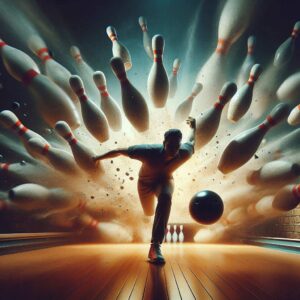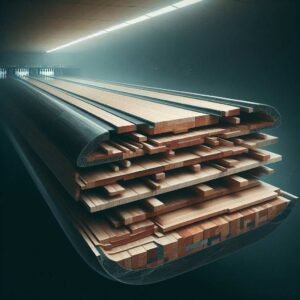Bowling is a beloved sport and recreational activity worldwide. Based on records, variations of bowling date back over 5,000 years to ancient Egypt and the Roman Empire days.
The sport has evolved across regions like Europe, Asia, and the Americas over the centuries. In its early days without lanes, bowlers would simply roll balls towards makeshift targets.
The first indoor bowling lanes emerged in 1840 in New York City with ten wooden pins set up. Since then, bowling alleys have continued advancing into high-tech, automated mechanisms able to host millions of players annually with computerized scoring, rentals, lessons, and more.
But how exactly do these modernized bowling alleys manage to run like clockwork for bowlers year after year? What happens behind the scenes to reset those pesky pins after each roll for the next player?
Why don’t the bowling balls end up scratched or stuck somewhere mid-game? Let’s analyze the main components that enable bowling alleys to operate week in, and week out.
The Ingenious Pinsetter Machine That Keeps the Pins Coming
At the heart of any bowling alley is the pinsetter machine. After each bowling ball knocks down pins, this mechanical system sweeps away downed pins and the remaining pins. Then the machine uprights the pins, and meticulously spots them in perfect position, before clearing out again below the lane for the next roll.
Without advanced pinsetter systems evolutionized from 1940s technology, bowling alleys would still rely on tedious manual labor. The automatic mechanics do the heavy lifting so bowlers can enjoy seamless gameplay.
Pinsetter Machine Components
Specialized pinsetter machines consist of several components working together:
- Sweep Bar – This horizontal bar sweeps down fallen pins to clear for the next setup. It may have rubber fingers attached to securely pick up the remaining pins.
- Pit – This is the underground cavity where pins fall and get conveyed away after the sweep.
- Table – This flat surface remains stationary to receive a new racked set of pins from the conveyor after the pit clears away the fallen ones.
- Kickbacks or Sidestops – These are spring-loaded side barriers that keep accurately spotted pins contained on the table until the sweep bar drops to trigger the next cycle.
- Gutters – Bowling lanes have these side channels to catch gutter balls rather than interfering with pin spots.
How Pinsetter Machines Work
When the bowling ball makes an impact, knocks over pins, and exits the lane, the automated cycle begins. Here’s how the components sequence:
- The sweep bar rapidly drops to around 25 mph to sweep down any remaining fallen pins on the lane into the underground pit area.
- The table lowers with it remaining centered.
- Kickbacks retract while the table stays down until the machine finishes clearing pins.
- Once empty, the pin conveyor loads a new racked set onto the stationary table
- The table then ascends with the freshly spotted pins, while kickbacks release to contain pins in a proper position.
- Once the table reaches its elevated locked position, the sweep bar retracts up into the starting position.
- Pins stay locked onto the lane by kickbacks until the next bowl triggers the sequence again!
This entire cycle completes within just 2-4 seconds before the ball returns to the bowler. Doing this 30 times an hour, a pinsetter machine can rack about 900-1200 sets daily per lane! Only minimal human assistance is needed to load conveyors, conduct repairs, and handle jams.
Advanced Engineering Circulates & Protects Pins
In earlier days of bowling, resetting pins required staff to manually haul, upright and spot pins after each roll. But with the system now fully automated by complex machinery, specialized conveyors and channels keep pins cycling without human handling.
Integrated pin conveyors connect to the pit to recirculate downed pins after the sweep bar clears them. Ball lifts remove the bowling balls, while troughs or channels feed them back to players.
Pins undergo inspection for defects, then get elevated via conveyor lifts to proceed with racking onto tables. Protective pin packaging shields the equipment during transfers.
Ongoing maintenance checks ensure these circulating pins aren’t jammed, damaged, or lost given the rigors of gameplay. Breakage, humidity, and other factors can hamper the pin machines. So bowling alleys conduct careful inspections for missing pins, examining between 150 to 300 thousand annually!
Consistent Oiling Patterns Are Key for Lanes
While the pinsetter handles pin logistics, proper lane conditioning provides the ideal slick surface for bowling balls to travel without sticking or straying offline.
Unique oiling machines evenly apply liquid protectants in precise patterns. Too little oil causes ball hooking and pin impact inconsistency. Too much oil reduces the traction needed to aim shots.
The professional bowling association regulates over 25 distinct oil patterns that alter ball paths. But most house bowling lanes have fairly basic oil patterns using boards (markings across lanes).
Common ones like THS (typical house shot) involve heavier oil concentrations around middle boards, tapering down to drier outside boards. This guides straight ball paths to prevent gutter turns.
Technicians inspect oil patterns under blacklights and reapply customized oil distributions before leagues or big tournaments. Unlike recreational bowlers, professional tournaments need extensive lane conditioning to meet sports regulations.
Regardless, evenly oiled lanes prevent equipment damage while guiding predictable ball rolls so bowlers at any skill level can have a chance to score strikes!
How Scoring Systems Track Bowling Talent and Stats
From the early days of bowling, keeping score relied on paper and pencils based on human eyes to count fallen pins in each frame. Now specialized scoring systems automatically track every player’s performance using advanced computers, sensors, and displays.
Optical recognition and scoring software detect how many pins drop after each roll. This instantly uploads scores to overhead screens and tournament systems that can be networked across locations.
Player profiles store names, statistics, and scores automatically through the alley’s database similar to online gaming platforms. Custom bowler cards may track scores over the years, analyzing averages and high games.
Scoring programs total pinfall each frame while calculating handicaps, splits, and complex combinations for experienced competitive leagues.
The systems signal players when it’s time to bowl each turn. Fun facts and trivia may even be displayed about players or bowling history in between turns. Printed scoresheets and receipts summarize player, team, and league results once the games wrap up.
The automated scoring enhances both recreational and competitive bowling by removing human error for precise stats and rankings. The technology leads the way for virtual national tournaments where bowlers across cities or countries connect online competing simultaneously. Bowling alleys now feel like video arcade game platforms with personalized progress tracking.
Bumper Lanes Keep Gutter Balls in Play for Beginners
Bowling alleys cater parties for all ages and skill levels. So innovative bumper lane systems help guide balls from veering into gutters, especially for young kids and new bowlers still learning aim. Integrated bumper guards essentially create a narrowed channel to catch wayward rolls, preventing gutter balls and frustration.
Bumper bowling lanes have guides embedded within gutters containing a shock absorption material, like foam padding. When enabled, this material can raise/lower to activate the ball guard boundaries.
The tech senses when standard vs. bumper play mode is active based on the player profile or lane rental. Encased optical infrared sensors also trigger the scoring system whenever a ball contacts bumpers during play on those lanes. This allows accurate scoring since bumpers keep balls in active play that would normally miss pins.
Glowing Lights, Music & Visual Effects Enhance Cosmic Bowling
Beyond standard bowling with bumpers, many entertainment venues have embraced “cosmic bowling” nights with dazzling lights, pumping music, and neon themes to attract young crowds. These events often run evenings or late nights with DJs creating a high-energy party setting surrounding lanes.
Blacklights may give bowling balls an electric aura trails following their path. Strobe lights flash in sync with soundtrack music, as abstract shapes glow from overhead planetarium projectors.
Psychedelic patterns swirl along carpets, seats, and walls for an immersive effect. Some alleys may even integrate dance floors with bowling lanes or have glittering disco balls scattering light refractions everywhere.
The charged environment paired with their favorite hit songs aims to get patrons pumped up, cheering loudly when pins crash down.
Even during standard daylight hours, various bowling alleys install disco lighting packages. Their systems can harmonize mesmerizing special effects between scoring monitor displays and lane LEDs that react to players’ rolls.
Configurable light animations and colors heighten the anticipation with each ball throw. Integrating these dynamic smart lighting systems certainly keeps facilities feeling modern versus traditional old bowling alleys. The tech fusion appeals across generations.
Making Strikes More Rewarding With Arcades and Food
Amidst all the technical equipment allowing smooth bowling operations, owners incorporate extensive amenities so guests enjoy comfortable, entertaining stays on-premises – potentially for hours on end.
Dining spaces featuring full bar menus, savory snacks, or sweet treats fuel players with refreshments when taking breaks between games. Multiple flatscreen televisions may surround lounge areas broadcasting sports channels or gaming consoles connected for casual use.
For additional amusement, kids and adults alike may collect tickets from incorporated arcade games to redeem fun prizes. High-demand attractions range from racing simulators, claw grab machines to carnival midway staples like whack-a-mole.
Redemption counters allow bowling alley guests to trade in ticket hauls from games of skill for toys, electronics, or novelty items to memorialize their visit.
Some brand-name entertainment chains have complimentary bowling with paid attraction passes for motion virtual reality rides and laser tag arenas.
Bowling alley multimedia experiences today fuse glowing concert visuals with a carnival midway variety for all interests to unwind after work or spend leisurely weekends.
The tech-enhanced amenities make strikes feel more victorious and foster longer stays for repeat bowling. Visitors may come just for the arcade offerings alone too. So diverse attractions beyond the bowling itself widen target audiences from casual to hardcore alley fans.
The Innovation Behind Bowling’s Enduring Popularity
Considering primitive forms of bowling date back millennia, its ability to withstand the test of time speaks volumes. The sport has clearly evolved from grass lawns to automated machines housing millions of players annually.
Once a simple pastime of rolling balls at makeshift pins, bowling now feels akin to a tech-infused gaming arena with tracks guiding balls gracefully back to players after knockdowns.
The returns and circulation of pins and balls seem to symbolize why bowling thrives generation after generation. The resetting nature of the game means anyone can play frame after frame while honing techniques.
Spares and strikes feel readily achievable on good days despite the occasional gutter ball. Physical activity mingles with friendly competition as players cheer on their teammates or battle one-on-one bowling showdowns.
Bowling alleys endure by leveraging scoring upgrades and amusement options that appeal across demographics. Owners analyze metrics to assess peak visiting hours, popular menus, and high-performing attractions at their facilities.
They arena-ize bowling inside cavernous halls embedding sci-fi aesthetics into lane lighting. Local pro shops supply personalized bowling balls fitted for guests’ hands to improve scores. Beginner instructions guide new players until they gain confidence in measuring strides, grips, and angles for a perfect strike.
At its heart, bowling remains a sport grounded in consistency. The lanes welcome practice. Knocking down all pins offers a rush of adrenaline and satisfaction whenever achieved by amateur or expert bowlers alike.
The reliability of rolling balls destined to hit targets and reset for the next round – boosted by mechanical pinsetters and computer tracking prowess – makes bowling an addicting activity rather than a fading pastime. Its timeless format persists enriched by continual upgrades.
Conclusion: Bowling Alleys Evolve But The Core Game Remains
In closing, the technical anatomy powering modern bowling components explains why alleys thrive as recreational hubs worldwide. But syntactic knowledge of pin conveyors, automated scoring, and oiling patterns misses the deeper heart of bowling’s staying power.
Beyond parts and software keeping balls in motion and pins in supply are the cheers, camaraderie, and collective thrill each strike delivers. Bowling’s repetitious simplicity compares to few other sports yet difficulty simultaneously in consistently bowling high scores.
The human emotions evoked between tossed gutter balls, tense split spares, and pure crowd ecstasy off stringing three strikes make bowling alley experiences distinctly rich.
Owners may tinker with blacklight formats, glow-in-the-dark balls, or lane-side dining amenities to maintain excitement. But the adrenaline that comes from spinning 12 pounds straight into a primed triangle rack of pins requires no gimmicks.
The sound of clattering knockdowns, the smell of lane oil, and racing heart as pins drop catalyze senses in ways no surrounding arcade game can replicate.
So while the technical equipment enabling flawless bowling is vital, soon-to-be bowlers don’t need this insider knowledge on machinery and computers to grab shoes or a colorful bowl for their first frame.
The simplicity of trying to barrel over pins revives recreational nostalgia across ages. And core bowling concepts have persevered from ancient days into tomorrow because no matter how far technology advances, the anticipation, in-the-moment intensity, and satisfaction of that ideal strike roll eternally through bloodstreams worldwide.
Frequently Asked Questions
How do bowling alleys reset pins?
Bowling alleys reset pins using specialized pinsetter machines that have components like sweep bars, pits, and kickbacks to clear fallen pins before spotting a new set on the lane.
How does the ball return in a bowling alley work?
Balls return via ball lifts and sloped troughs that run along the side of lanes. These channel the balls back to the players.
How do bowling pins get set up?
Pinsetter machines automatically set up pins. Once sweep bars clear fallen pins into pits below, conveyor belts load new pins which get elevated and spotted into perfect position on the lane table.
Where do bowling balls come out of?
Balls emerge from ball lifts connected to ball return troughs along the sides of lanes, placed conveniently back at players’ starting launch points.
Where do bowling pins go after they are knocked down?
Fallen pins go into underground pits below lanes where conveyors transfer them to get inspected, recycled and eventually relayed back to pinsetter machines for resetting.
What do bowling alleys do with old pins?
Old, damaged pins may be sold for repurposing. Otherwise alleys discard unsalvageable pins and replace with fresh stocks to maintain quality equipment.
Can you throw your back out bowling?
Yes, improper bowling with jerking motions can strain back muscles. Best practices involve straight approaches, calm releases and following through without twisting that reduces injury risk.
Why do you get a spare in bowling?
A spare is awarded when players knock down all remaining pins after missing on the first roll that game. It gives a chance to score bonus points if the next roll registers pins as well.
How do strikes and spares work in bowling?
Players record a strike when knocking down all 10 pins on the first roll. This earns bonus points for subsequent rolls. Spares indicate clearing pins on the second roll, earning one bonus roll point.





